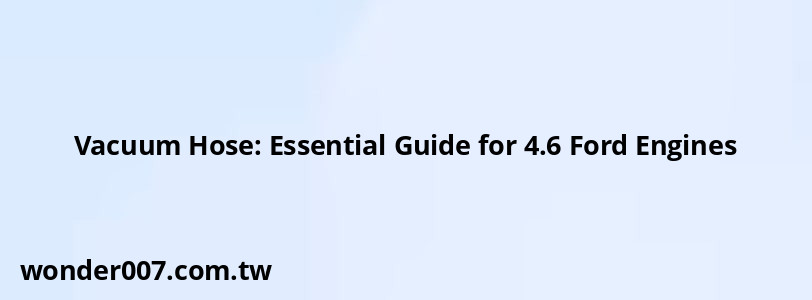Vacuum Hose: Essential Guide for 4.6 Ford Engines

Understanding the vacuum hose system in a 4.6 Ford engine is crucial for maintaining optimal performance and addressing any issues that may arise. This guide provides essential information regarding the vacuum lines, their functions, and common problems associated with them.
Overview of Vacuum Lines in 4.6 Ford Engines
The vacuum system in a 4.6 Ford engine plays a vital role in various engine functions, including:
- EGR (Exhaust Gas Recirculation): Helps reduce emissions by recirculating a portion of the exhaust back into the intake manifold.
- PCV (Positive Crankcase Ventilation): Aids in reducing harmful emissions from the crankcase.
- Brake Booster: Provides additional power assist for braking.
These systems rely on properly functioning vacuum lines to maintain engine efficiency and performance.
Common Issues with Vacuum Lines
Several problems can arise with vacuum hoses, leading to rough idling, poor fuel economy, or engine performance issues. Here are some common symptoms and their potential causes:
- Rough Idle: Often caused by a disconnected or damaged vacuum line. A leak can disrupt the air-fuel mixture, leading to an unstable idle.
- Poor Acceleration: This can occur if there is a significant vacuum leak affecting the intake manifold's pressure.
- Check Engine Light: A malfunctioning vacuum line can trigger diagnostic trouble codes related to emissions or engine performance.
Identifying and Replacing Vacuum Hoses
Steps to Diagnose Vacuum Line Issues
1. Visual Inspection: Check all visible hoses for cracks, splits, or disconnections.
2. Listen for Hissing Sounds: A hissing noise while the engine is running may indicate a leak.
3. Use a Vacuum Gauge: Connect a vacuum gauge to check for proper readings; normal idle should be between 18-22 inHg.
Replacement Guidelines
When replacing vacuum hoses, consider the following:
- Use OEM Parts: For best results, use original equipment manufacturer (OEM) parts or high-quality aftermarket hoses designed specifically for your vehicle model.
- Proper Routing: Ensure that new hoses are routed correctly according to the vehicle's specifications to avoid interference with other components.
- Secure Connections: Use appropriate clamps and fittings to ensure that hoses are securely attached and do not leak.
Maintenance Tips
To maintain your vacuum system effectively:
- Regular Inspections: Periodically check vacuum lines for wear and tear, especially if experiencing performance issues.
- Replace as Needed: Don’t hesitate to replace old or damaged hoses promptly to prevent further engine problems.
- Keep It Clean: Ensure that connections are clean and free from debris to maintain a good seal.
FAQs About Vacuum Hoses in 4.6 Ford Engines
- What are the signs of a bad vacuum hose?
Common signs include rough idling, poor acceleration, and illuminated check engine light. - Can I use regular rubber hoses for replacement?
It's recommended to use specific vacuum hoses designed for automotive applications due to their reinforced structure. - How often should I check my vacuum lines?
Regular inspections every few months or during routine maintenance can help catch issues early.
Related Posts
-
Ford Expedition: Folding the 2nd Row Middle Seat Guide
29-01-2025 • 153 views -
Brake Light Bulb Fault Ford Escape: Quick Fix Guide
28-01-2025 • 151 views -
2009 Toyota Camry 2.4: Serpentine Belt Diagram and Replacement Guide
27-01-2025 • 200 views -
Santa Fe Sport: Oil Type Guide for 2018 Models
28-01-2025 • 203 views -
2006 Ford F150 5.4 Serpentine Belt Routing Guide
27-01-2025 • 208 views
Latest Posts
-
How To Turn Off Paddle Shifters Mercedes
01-02-2025 • 387 views -
Are O2 Sensors Covered Under Warranty
01-02-2025 • 378 views -
Power Steering Fluid Leak On Passenger Side
01-02-2025 • 461 views -
2015 Chevy Traverse AC Recharge Port Location
01-02-2025 • 417 views -
Rear Brake Caliper Piston Won't Compress
01-02-2025 • 361 views
Popular Posts
-
V12 Engine Costs: What You Need to Know
26-01-2025 • 688 views -
Power Steering and ABS Light On: Causes and Solutions
27-01-2025 • 649 views -
EPC Light: Understanding Causes and Solutions
26-01-2025 • 1065 views -
Hino Warning Lights: Understanding Dashboard Alerts
26-01-2025 • 794 views -
Toyota Hiace: Fuel Efficiency Insights for 2025
26-01-2025 • 645 views
